Strategic Marketing Analysis: Harwell Group, Zest, and Industry Trends
VerifiedAdded on 2023/06/14
|9
|2738
|180
Report
AI Summary
This report provides a comprehensive analysis of Harwell Group's marketing strategies, particularly focusing on the successful introduction of their healthy energy drink, 'Zest,' and evaluating the potential incorporation of the fashion industry into their business model. The analysis employs strategic models such as SWOT, PEST, and Blue Ocean Strategy to assess 'Zest's market position and potential for growth. It also considers the product life cycle of the fashion industry, concluding that its declining stage makes it a risky investment. The report offers recommendations for Harwell Group to sustain 'Zest's success, including increased advertising, strategic alliances, and participation in promotional events, while advising caution regarding further investment in the fashion industry due to its unpredictable nature and potential for decline.
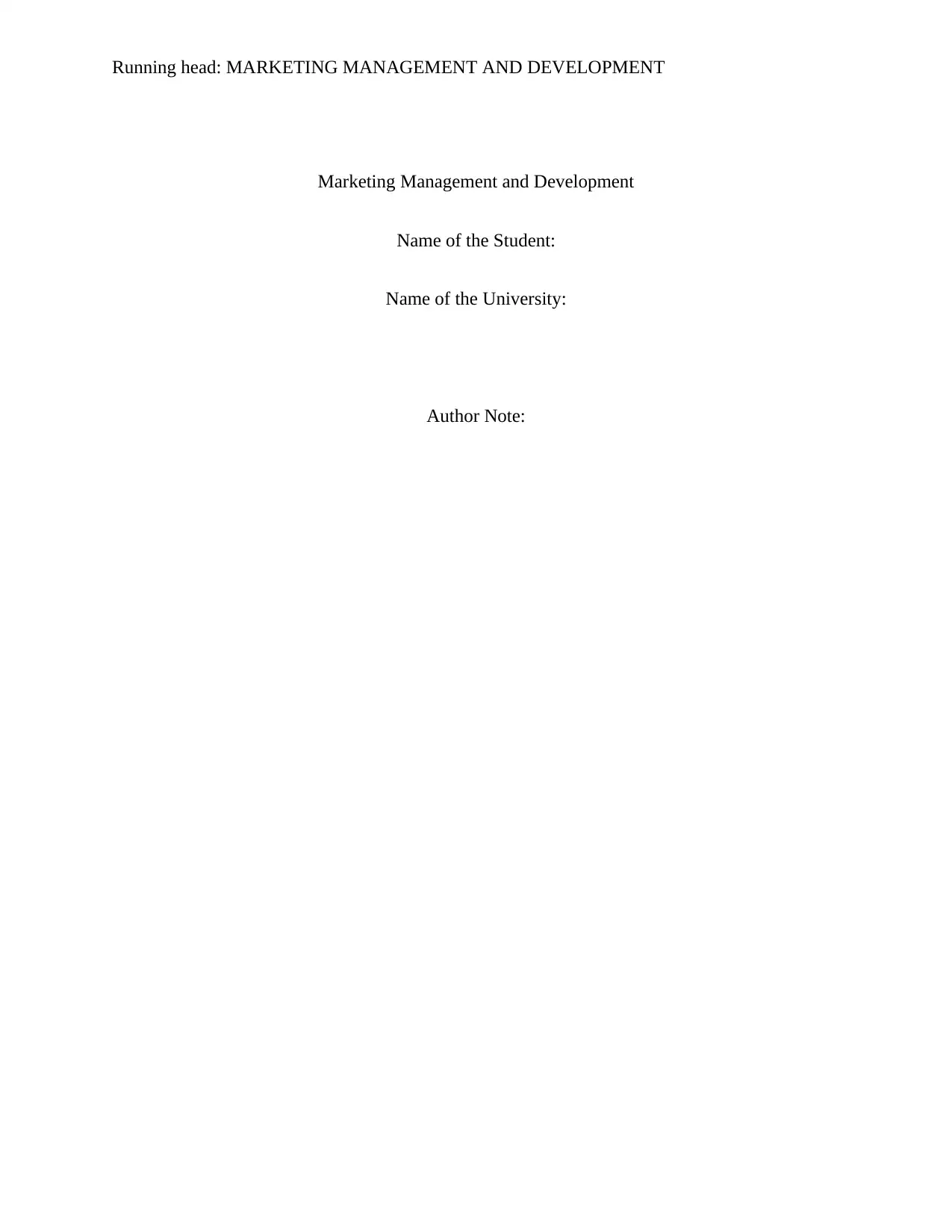
Running head: MARKETING MANAGEMENT AND DEVELOPMENT
Marketing Management and Development
Name of the Student:
Name of the University:
Author Note:
Marketing Management and Development
Name of the Student:
Name of the University:
Author Note:
Paraphrase This Document
Need a fresh take? Get an instant paraphrase of this document with our AI Paraphraser
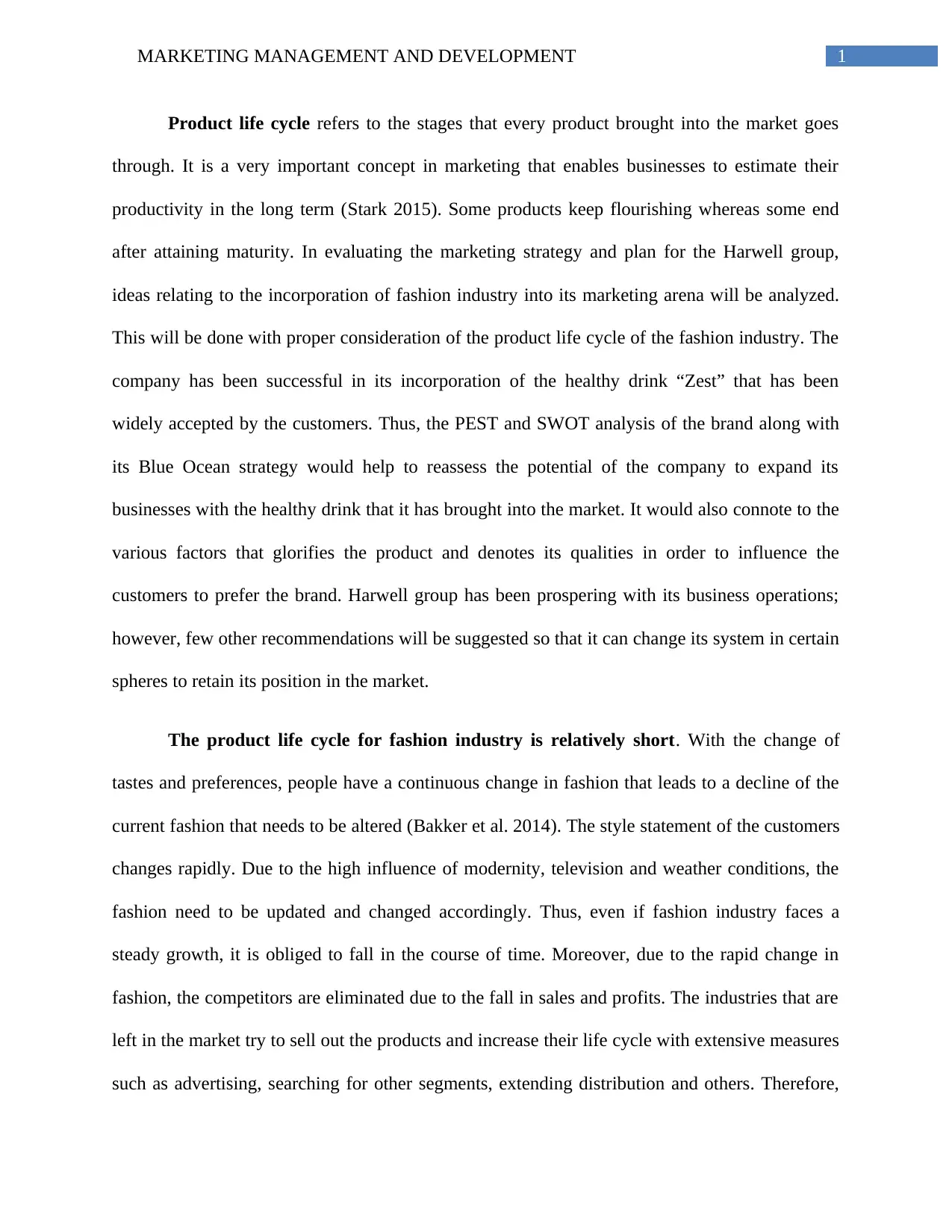
1MARKETING MANAGEMENT AND DEVELOPMENT
Product life cycle refers to the stages that every product brought into the market goes
through. It is a very important concept in marketing that enables businesses to estimate their
productivity in the long term (Stark 2015). Some products keep flourishing whereas some end
after attaining maturity. In evaluating the marketing strategy and plan for the Harwell group,
ideas relating to the incorporation of fashion industry into its marketing arena will be analyzed.
This will be done with proper consideration of the product life cycle of the fashion industry. The
company has been successful in its incorporation of the healthy drink “Zest” that has been
widely accepted by the customers. Thus, the PEST and SWOT analysis of the brand along with
its Blue Ocean strategy would help to reassess the potential of the company to expand its
businesses with the healthy drink that it has brought into the market. It would also connote to the
various factors that glorifies the product and denotes its qualities in order to influence the
customers to prefer the brand. Harwell group has been prospering with its business operations;
however, few other recommendations will be suggested so that it can change its system in certain
spheres to retain its position in the market.
The product life cycle for fashion industry is relatively short. With the change of
tastes and preferences, people have a continuous change in fashion that leads to a decline of the
current fashion that needs to be altered (Bakker et al. 2014). The style statement of the customers
changes rapidly. Due to the high influence of modernity, television and weather conditions, the
fashion need to be updated and changed accordingly. Thus, even if fashion industry faces a
steady growth, it is obliged to fall in the course of time. Moreover, due to the rapid change in
fashion, the competitors are eliminated due to the fall in sales and profits. The industries that are
left in the market try to sell out the products and increase their life cycle with extensive measures
such as advertising, searching for other segments, extending distribution and others. Therefore,
Product life cycle refers to the stages that every product brought into the market goes
through. It is a very important concept in marketing that enables businesses to estimate their
productivity in the long term (Stark 2015). Some products keep flourishing whereas some end
after attaining maturity. In evaluating the marketing strategy and plan for the Harwell group,
ideas relating to the incorporation of fashion industry into its marketing arena will be analyzed.
This will be done with proper consideration of the product life cycle of the fashion industry. The
company has been successful in its incorporation of the healthy drink “Zest” that has been
widely accepted by the customers. Thus, the PEST and SWOT analysis of the brand along with
its Blue Ocean strategy would help to reassess the potential of the company to expand its
businesses with the healthy drink that it has brought into the market. It would also connote to the
various factors that glorifies the product and denotes its qualities in order to influence the
customers to prefer the brand. Harwell group has been prospering with its business operations;
however, few other recommendations will be suggested so that it can change its system in certain
spheres to retain its position in the market.
The product life cycle for fashion industry is relatively short. With the change of
tastes and preferences, people have a continuous change in fashion that leads to a decline of the
current fashion that needs to be altered (Bakker et al. 2014). The style statement of the customers
changes rapidly. Due to the high influence of modernity, television and weather conditions, the
fashion need to be updated and changed accordingly. Thus, even if fashion industry faces a
steady growth, it is obliged to fall in the course of time. Moreover, due to the rapid change in
fashion, the competitors are eliminated due to the fall in sales and profits. The industries that are
left in the market try to sell out the products and increase their life cycle with extensive measures
such as advertising, searching for other segments, extending distribution and others. Therefore,
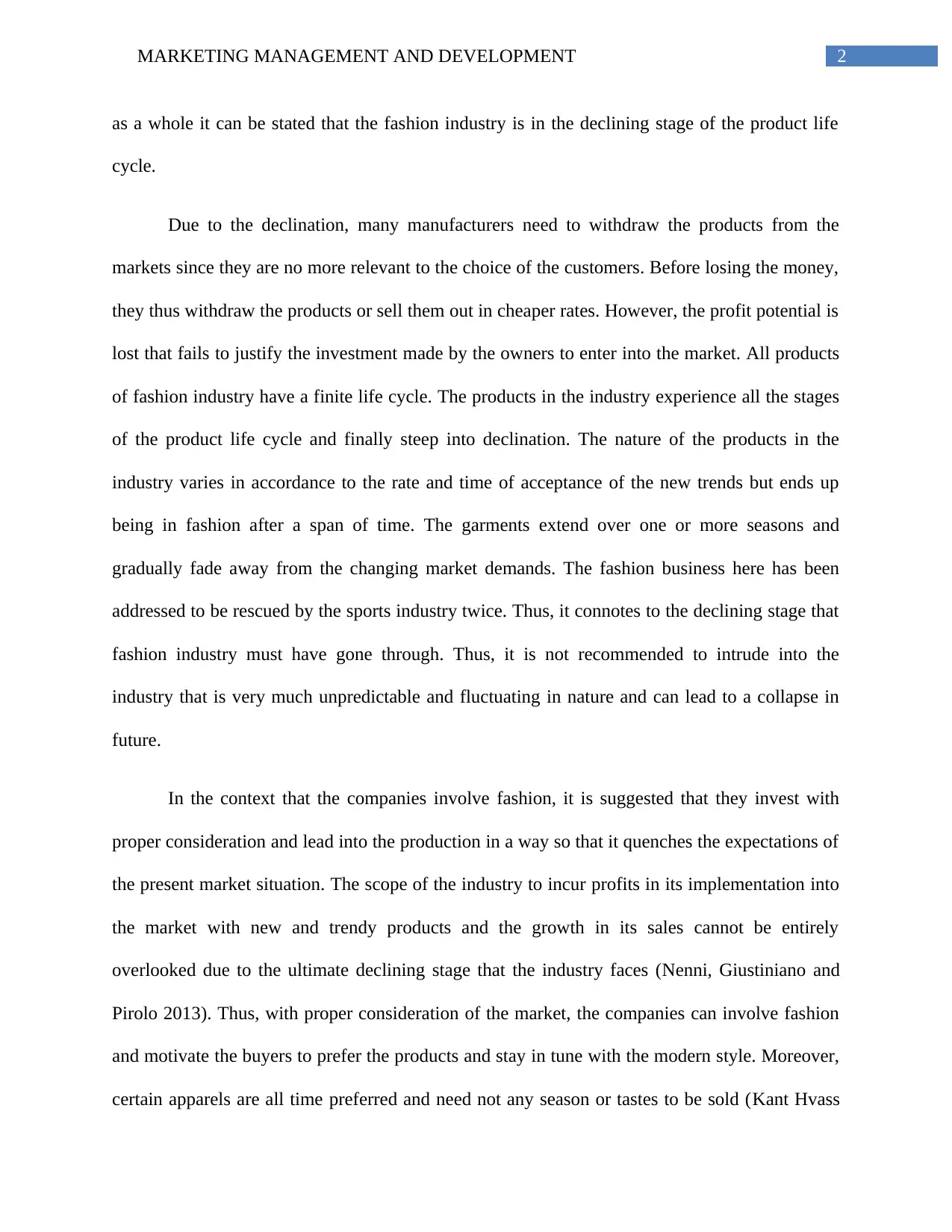
2MARKETING MANAGEMENT AND DEVELOPMENT
as a whole it can be stated that the fashion industry is in the declining stage of the product life
cycle.
Due to the declination, many manufacturers need to withdraw the products from the
markets since they are no more relevant to the choice of the customers. Before losing the money,
they thus withdraw the products or sell them out in cheaper rates. However, the profit potential is
lost that fails to justify the investment made by the owners to enter into the market. All products
of fashion industry have a finite life cycle. The products in the industry experience all the stages
of the product life cycle and finally steep into declination. The nature of the products in the
industry varies in accordance to the rate and time of acceptance of the new trends but ends up
being in fashion after a span of time. The garments extend over one or more seasons and
gradually fade away from the changing market demands. The fashion business here has been
addressed to be rescued by the sports industry twice. Thus, it connotes to the declining stage that
fashion industry must have gone through. Thus, it is not recommended to intrude into the
industry that is very much unpredictable and fluctuating in nature and can lead to a collapse in
future.
In the context that the companies involve fashion, it is suggested that they invest with
proper consideration and lead into the production in a way so that it quenches the expectations of
the present market situation. The scope of the industry to incur profits in its implementation into
the market with new and trendy products and the growth in its sales cannot be entirely
overlooked due to the ultimate declining stage that the industry faces (Nenni, Giustiniano and
Pirolo 2013). Thus, with proper consideration of the market, the companies can involve fashion
and motivate the buyers to prefer the products and stay in tune with the modern style. Moreover,
certain apparels are all time preferred and need not any season or tastes to be sold (Kant Hvass
as a whole it can be stated that the fashion industry is in the declining stage of the product life
cycle.
Due to the declination, many manufacturers need to withdraw the products from the
markets since they are no more relevant to the choice of the customers. Before losing the money,
they thus withdraw the products or sell them out in cheaper rates. However, the profit potential is
lost that fails to justify the investment made by the owners to enter into the market. All products
of fashion industry have a finite life cycle. The products in the industry experience all the stages
of the product life cycle and finally steep into declination. The nature of the products in the
industry varies in accordance to the rate and time of acceptance of the new trends but ends up
being in fashion after a span of time. The garments extend over one or more seasons and
gradually fade away from the changing market demands. The fashion business here has been
addressed to be rescued by the sports industry twice. Thus, it connotes to the declining stage that
fashion industry must have gone through. Thus, it is not recommended to intrude into the
industry that is very much unpredictable and fluctuating in nature and can lead to a collapse in
future.
In the context that the companies involve fashion, it is suggested that they invest with
proper consideration and lead into the production in a way so that it quenches the expectations of
the present market situation. The scope of the industry to incur profits in its implementation into
the market with new and trendy products and the growth in its sales cannot be entirely
overlooked due to the ultimate declining stage that the industry faces (Nenni, Giustiniano and
Pirolo 2013). Thus, with proper consideration of the market, the companies can involve fashion
and motivate the buyers to prefer the products and stay in tune with the modern style. Moreover,
certain apparels are all time preferred and need not any season or tastes to be sold (Kant Hvass
⊘ This is a preview!⊘
Do you want full access?
Subscribe today to unlock all pages.

Trusted by 1+ million students worldwide
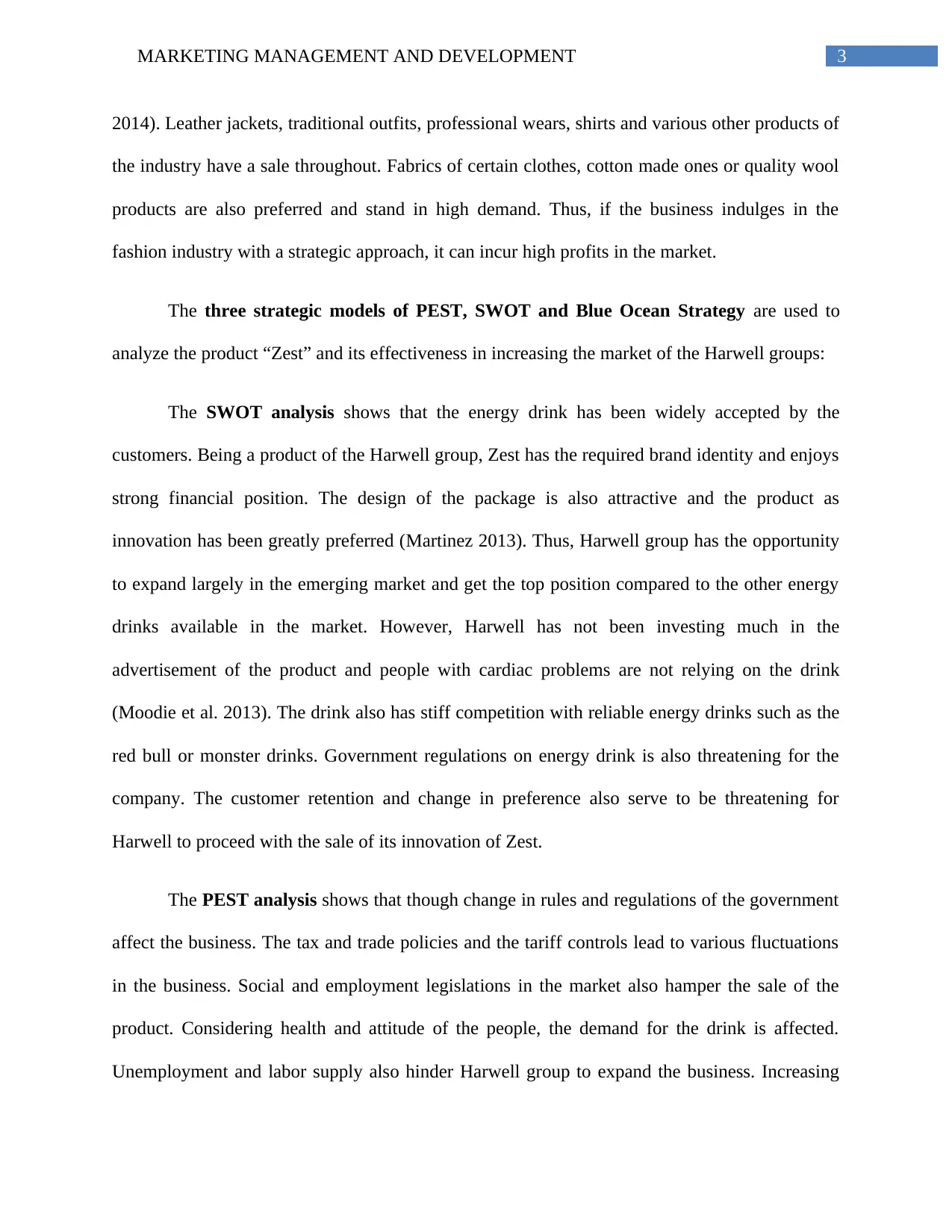
3MARKETING MANAGEMENT AND DEVELOPMENT
2014). Leather jackets, traditional outfits, professional wears, shirts and various other products of
the industry have a sale throughout. Fabrics of certain clothes, cotton made ones or quality wool
products are also preferred and stand in high demand. Thus, if the business indulges in the
fashion industry with a strategic approach, it can incur high profits in the market.
The three strategic models of PEST, SWOT and Blue Ocean Strategy are used to
analyze the product “Zest” and its effectiveness in increasing the market of the Harwell groups:
The SWOT analysis shows that the energy drink has been widely accepted by the
customers. Being a product of the Harwell group, Zest has the required brand identity and enjoys
strong financial position. The design of the package is also attractive and the product as
innovation has been greatly preferred (Martinez 2013). Thus, Harwell group has the opportunity
to expand largely in the emerging market and get the top position compared to the other energy
drinks available in the market. However, Harwell has not been investing much in the
advertisement of the product and people with cardiac problems are not relying on the drink
(Moodie et al. 2013). The drink also has stiff competition with reliable energy drinks such as the
red bull or monster drinks. Government regulations on energy drink is also threatening for the
company. The customer retention and change in preference also serve to be threatening for
Harwell to proceed with the sale of its innovation of Zest.
The PEST analysis shows that though change in rules and regulations of the government
affect the business. The tax and trade policies and the tariff controls lead to various fluctuations
in the business. Social and employment legislations in the market also hamper the sale of the
product. Considering health and attitude of the people, the demand for the drink is affected.
Unemployment and labor supply also hinder Harwell group to expand the business. Increasing
2014). Leather jackets, traditional outfits, professional wears, shirts and various other products of
the industry have a sale throughout. Fabrics of certain clothes, cotton made ones or quality wool
products are also preferred and stand in high demand. Thus, if the business indulges in the
fashion industry with a strategic approach, it can incur high profits in the market.
The three strategic models of PEST, SWOT and Blue Ocean Strategy are used to
analyze the product “Zest” and its effectiveness in increasing the market of the Harwell groups:
The SWOT analysis shows that the energy drink has been widely accepted by the
customers. Being a product of the Harwell group, Zest has the required brand identity and enjoys
strong financial position. The design of the package is also attractive and the product as
innovation has been greatly preferred (Martinez 2013). Thus, Harwell group has the opportunity
to expand largely in the emerging market and get the top position compared to the other energy
drinks available in the market. However, Harwell has not been investing much in the
advertisement of the product and people with cardiac problems are not relying on the drink
(Moodie et al. 2013). The drink also has stiff competition with reliable energy drinks such as the
red bull or monster drinks. Government regulations on energy drink is also threatening for the
company. The customer retention and change in preference also serve to be threatening for
Harwell to proceed with the sale of its innovation of Zest.
The PEST analysis shows that though change in rules and regulations of the government
affect the business. The tax and trade policies and the tariff controls lead to various fluctuations
in the business. Social and employment legislations in the market also hamper the sale of the
product. Considering health and attitude of the people, the demand for the drink is affected.
Unemployment and labor supply also hinder Harwell group to expand the business. Increasing
Paraphrase This Document
Need a fresh take? Get an instant paraphrase of this document with our AI Paraphraser
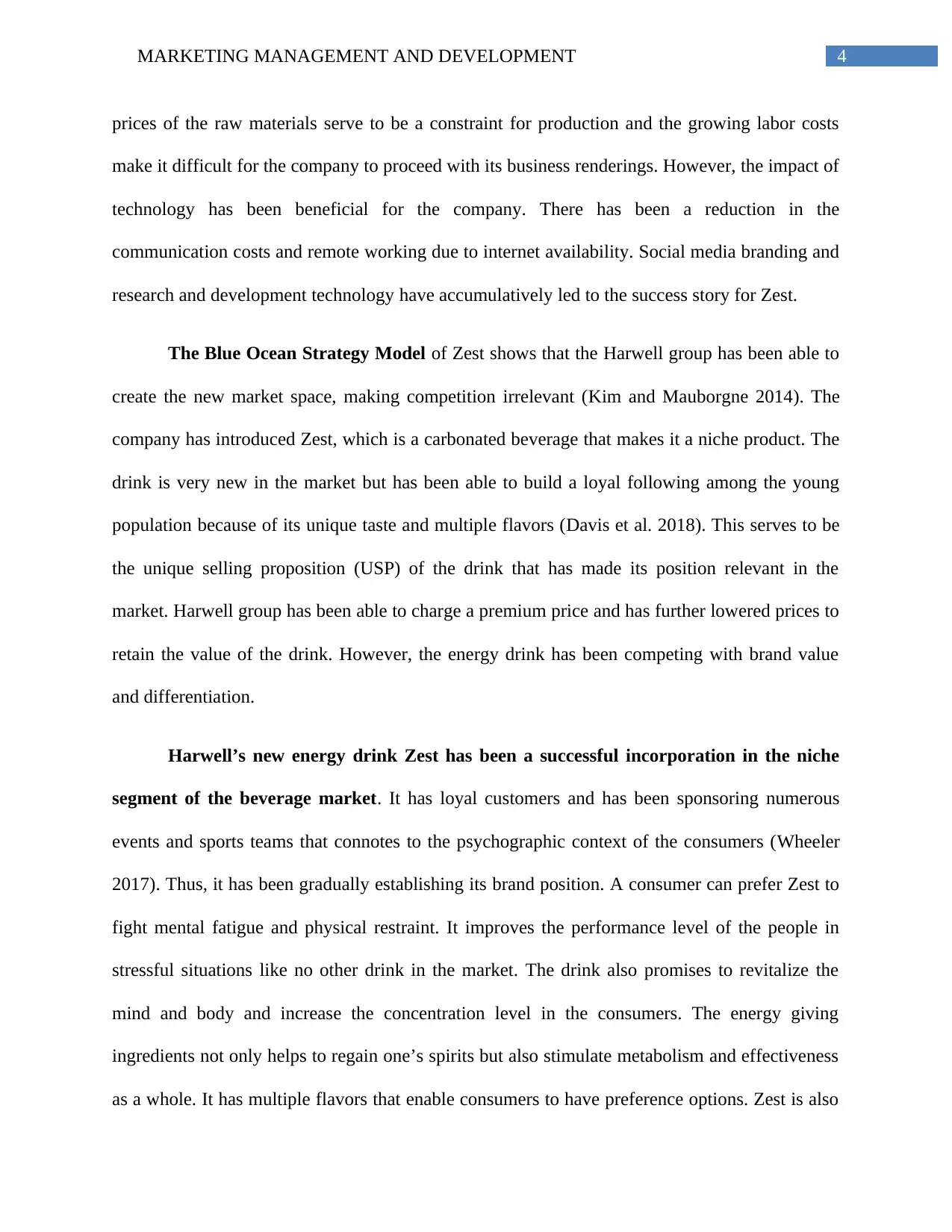
4MARKETING MANAGEMENT AND DEVELOPMENT
prices of the raw materials serve to be a constraint for production and the growing labor costs
make it difficult for the company to proceed with its business renderings. However, the impact of
technology has been beneficial for the company. There has been a reduction in the
communication costs and remote working due to internet availability. Social media branding and
research and development technology have accumulatively led to the success story for Zest.
The Blue Ocean Strategy Model of Zest shows that the Harwell group has been able to
create the new market space, making competition irrelevant (Kim and Mauborgne 2014). The
company has introduced Zest, which is a carbonated beverage that makes it a niche product. The
drink is very new in the market but has been able to build a loyal following among the young
population because of its unique taste and multiple flavors (Davis et al. 2018). This serves to be
the unique selling proposition (USP) of the drink that has made its position relevant in the
market. Harwell group has been able to charge a premium price and has further lowered prices to
retain the value of the drink. However, the energy drink has been competing with brand value
and differentiation.
Harwell’s new energy drink Zest has been a successful incorporation in the niche
segment of the beverage market. It has loyal customers and has been sponsoring numerous
events and sports teams that connotes to the psychographic context of the consumers (Wheeler
2017). Thus, it has been gradually establishing its brand position. A consumer can prefer Zest to
fight mental fatigue and physical restraint. It improves the performance level of the people in
stressful situations like no other drink in the market. The drink also promises to revitalize the
mind and body and increase the concentration level in the consumers. The energy giving
ingredients not only helps to regain one’s spirits but also stimulate metabolism and effectiveness
as a whole. It has multiple flavors that enable consumers to have preference options. Zest is also
prices of the raw materials serve to be a constraint for production and the growing labor costs
make it difficult for the company to proceed with its business renderings. However, the impact of
technology has been beneficial for the company. There has been a reduction in the
communication costs and remote working due to internet availability. Social media branding and
research and development technology have accumulatively led to the success story for Zest.
The Blue Ocean Strategy Model of Zest shows that the Harwell group has been able to
create the new market space, making competition irrelevant (Kim and Mauborgne 2014). The
company has introduced Zest, which is a carbonated beverage that makes it a niche product. The
drink is very new in the market but has been able to build a loyal following among the young
population because of its unique taste and multiple flavors (Davis et al. 2018). This serves to be
the unique selling proposition (USP) of the drink that has made its position relevant in the
market. Harwell group has been able to charge a premium price and has further lowered prices to
retain the value of the drink. However, the energy drink has been competing with brand value
and differentiation.
Harwell’s new energy drink Zest has been a successful incorporation in the niche
segment of the beverage market. It has loyal customers and has been sponsoring numerous
events and sports teams that connotes to the psychographic context of the consumers (Wheeler
2017). Thus, it has been gradually establishing its brand position. A consumer can prefer Zest to
fight mental fatigue and physical restraint. It improves the performance level of the people in
stressful situations like no other drink in the market. The drink also promises to revitalize the
mind and body and increase the concentration level in the consumers. The energy giving
ingredients not only helps to regain one’s spirits but also stimulate metabolism and effectiveness
as a whole. It has multiple flavors that enable consumers to have preference options. Zest is also
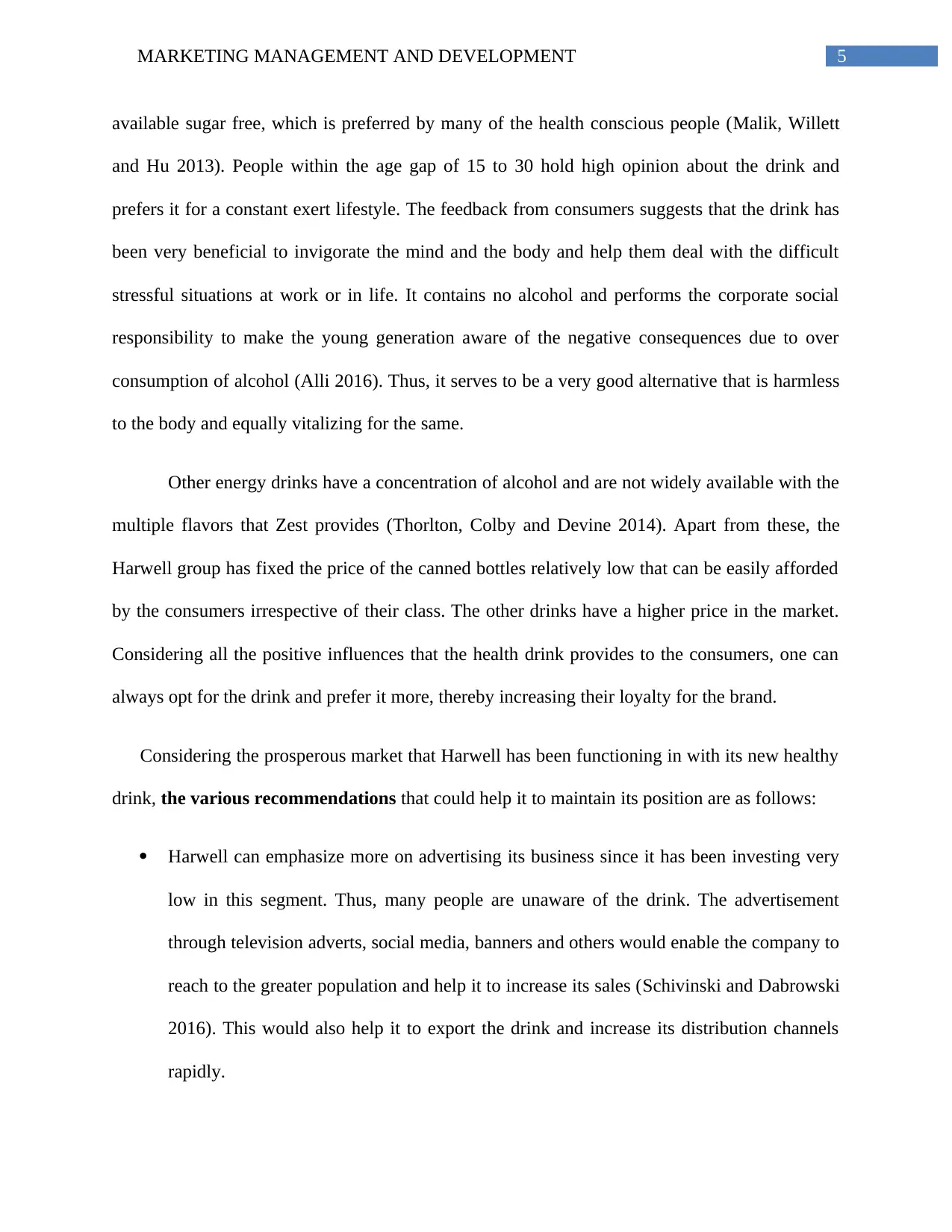
5MARKETING MANAGEMENT AND DEVELOPMENT
available sugar free, which is preferred by many of the health conscious people (Malik, Willett
and Hu 2013). People within the age gap of 15 to 30 hold high opinion about the drink and
prefers it for a constant exert lifestyle. The feedback from consumers suggests that the drink has
been very beneficial to invigorate the mind and the body and help them deal with the difficult
stressful situations at work or in life. It contains no alcohol and performs the corporate social
responsibility to make the young generation aware of the negative consequences due to over
consumption of alcohol (Alli 2016). Thus, it serves to be a very good alternative that is harmless
to the body and equally vitalizing for the same.
Other energy drinks have a concentration of alcohol and are not widely available with the
multiple flavors that Zest provides (Thorlton, Colby and Devine 2014). Apart from these, the
Harwell group has fixed the price of the canned bottles relatively low that can be easily afforded
by the consumers irrespective of their class. The other drinks have a higher price in the market.
Considering all the positive influences that the health drink provides to the consumers, one can
always opt for the drink and prefer it more, thereby increasing their loyalty for the brand.
Considering the prosperous market that Harwell has been functioning in with its new healthy
drink, the various recommendations that could help it to maintain its position are as follows:
Harwell can emphasize more on advertising its business since it has been investing very
low in this segment. Thus, many people are unaware of the drink. The advertisement
through television adverts, social media, banners and others would enable the company to
reach to the greater population and help it to increase its sales (Schivinski and Dabrowski
2016). This would also help it to export the drink and increase its distribution channels
rapidly.
available sugar free, which is preferred by many of the health conscious people (Malik, Willett
and Hu 2013). People within the age gap of 15 to 30 hold high opinion about the drink and
prefers it for a constant exert lifestyle. The feedback from consumers suggests that the drink has
been very beneficial to invigorate the mind and the body and help them deal with the difficult
stressful situations at work or in life. It contains no alcohol and performs the corporate social
responsibility to make the young generation aware of the negative consequences due to over
consumption of alcohol (Alli 2016). Thus, it serves to be a very good alternative that is harmless
to the body and equally vitalizing for the same.
Other energy drinks have a concentration of alcohol and are not widely available with the
multiple flavors that Zest provides (Thorlton, Colby and Devine 2014). Apart from these, the
Harwell group has fixed the price of the canned bottles relatively low that can be easily afforded
by the consumers irrespective of their class. The other drinks have a higher price in the market.
Considering all the positive influences that the health drink provides to the consumers, one can
always opt for the drink and prefer it more, thereby increasing their loyalty for the brand.
Considering the prosperous market that Harwell has been functioning in with its new healthy
drink, the various recommendations that could help it to maintain its position are as follows:
Harwell can emphasize more on advertising its business since it has been investing very
low in this segment. Thus, many people are unaware of the drink. The advertisement
through television adverts, social media, banners and others would enable the company to
reach to the greater population and help it to increase its sales (Schivinski and Dabrowski
2016). This would also help it to export the drink and increase its distribution channels
rapidly.
⊘ This is a preview!⊘
Do you want full access?
Subscribe today to unlock all pages.

Trusted by 1+ million students worldwide
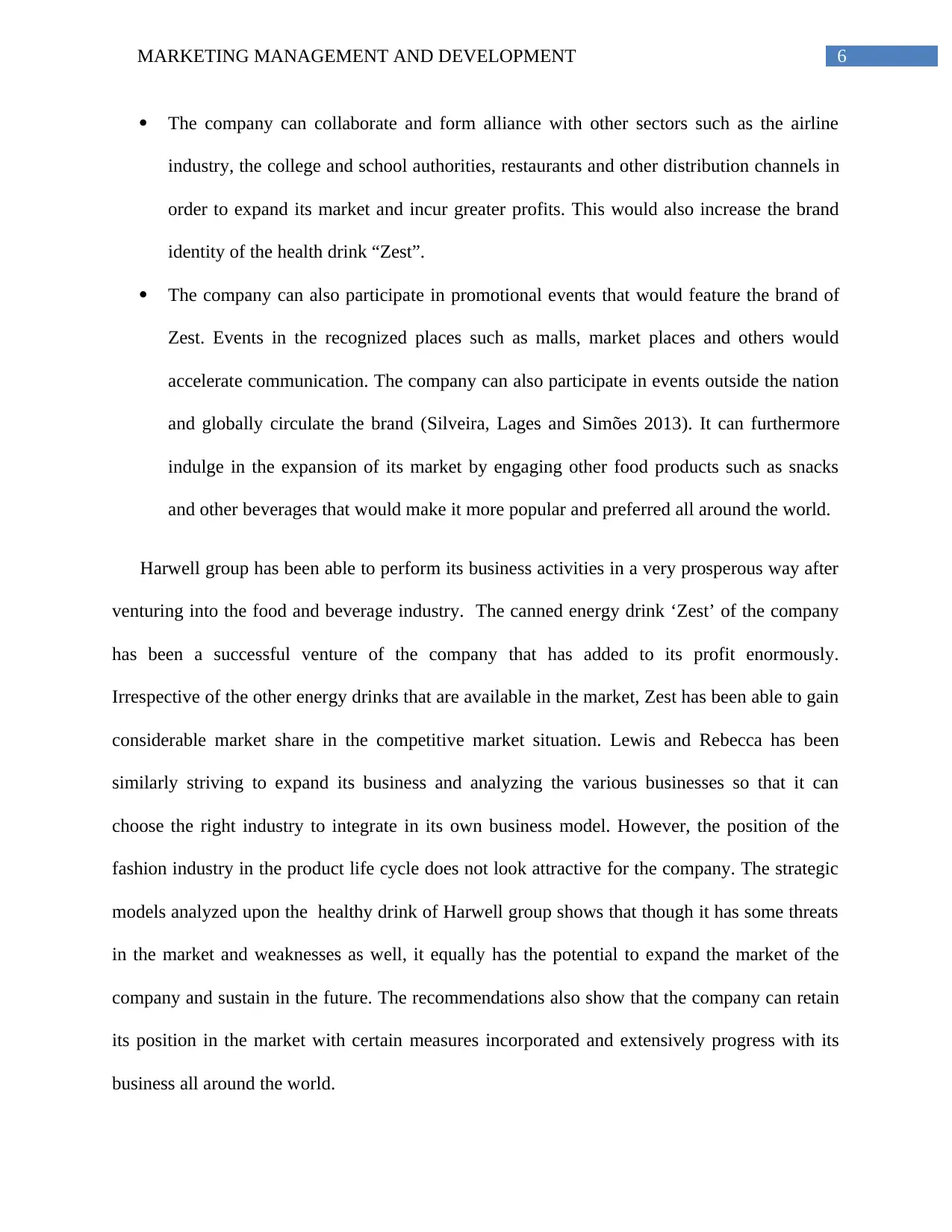
6MARKETING MANAGEMENT AND DEVELOPMENT
The company can collaborate and form alliance with other sectors such as the airline
industry, the college and school authorities, restaurants and other distribution channels in
order to expand its market and incur greater profits. This would also increase the brand
identity of the health drink “Zest”.
The company can also participate in promotional events that would feature the brand of
Zest. Events in the recognized places such as malls, market places and others would
accelerate communication. The company can also participate in events outside the nation
and globally circulate the brand (Silveira, Lages and Simões 2013). It can furthermore
indulge in the expansion of its market by engaging other food products such as snacks
and other beverages that would make it more popular and preferred all around the world.
Harwell group has been able to perform its business activities in a very prosperous way after
venturing into the food and beverage industry. The canned energy drink ‘Zest’ of the company
has been a successful venture of the company that has added to its profit enormously.
Irrespective of the other energy drinks that are available in the market, Zest has been able to gain
considerable market share in the competitive market situation. Lewis and Rebecca has been
similarly striving to expand its business and analyzing the various businesses so that it can
choose the right industry to integrate in its own business model. However, the position of the
fashion industry in the product life cycle does not look attractive for the company. The strategic
models analyzed upon the healthy drink of Harwell group shows that though it has some threats
in the market and weaknesses as well, it equally has the potential to expand the market of the
company and sustain in the future. The recommendations also show that the company can retain
its position in the market with certain measures incorporated and extensively progress with its
business all around the world.
The company can collaborate and form alliance with other sectors such as the airline
industry, the college and school authorities, restaurants and other distribution channels in
order to expand its market and incur greater profits. This would also increase the brand
identity of the health drink “Zest”.
The company can also participate in promotional events that would feature the brand of
Zest. Events in the recognized places such as malls, market places and others would
accelerate communication. The company can also participate in events outside the nation
and globally circulate the brand (Silveira, Lages and Simões 2013). It can furthermore
indulge in the expansion of its market by engaging other food products such as snacks
and other beverages that would make it more popular and preferred all around the world.
Harwell group has been able to perform its business activities in a very prosperous way after
venturing into the food and beverage industry. The canned energy drink ‘Zest’ of the company
has been a successful venture of the company that has added to its profit enormously.
Irrespective of the other energy drinks that are available in the market, Zest has been able to gain
considerable market share in the competitive market situation. Lewis and Rebecca has been
similarly striving to expand its business and analyzing the various businesses so that it can
choose the right industry to integrate in its own business model. However, the position of the
fashion industry in the product life cycle does not look attractive for the company. The strategic
models analyzed upon the healthy drink of Harwell group shows that though it has some threats
in the market and weaknesses as well, it equally has the potential to expand the market of the
company and sustain in the future. The recommendations also show that the company can retain
its position in the market with certain measures incorporated and extensively progress with its
business all around the world.
Paraphrase This Document
Need a fresh take? Get an instant paraphrase of this document with our AI Paraphraser
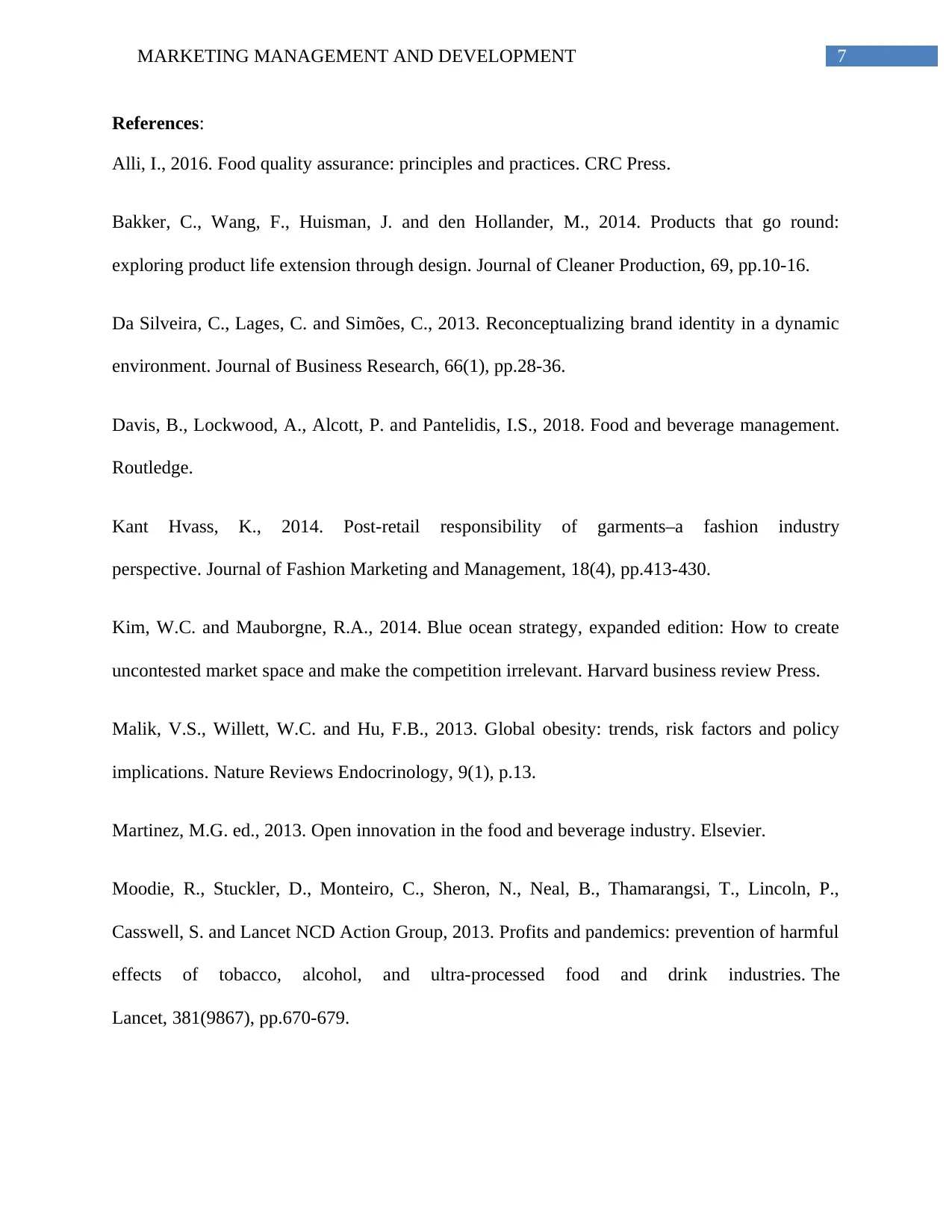
7MARKETING MANAGEMENT AND DEVELOPMENT
References:
Alli, I., 2016. Food quality assurance: principles and practices. CRC Press.
Bakker, C., Wang, F., Huisman, J. and den Hollander, M., 2014. Products that go round:
exploring product life extension through design. Journal of Cleaner Production, 69, pp.10-16.
Da Silveira, C., Lages, C. and Simões, C., 2013. Reconceptualizing brand identity in a dynamic
environment. Journal of Business Research, 66(1), pp.28-36.
Davis, B., Lockwood, A., Alcott, P. and Pantelidis, I.S., 2018. Food and beverage management.
Routledge.
Kant Hvass, K., 2014. Post-retail responsibility of garments–a fashion industry
perspective. Journal of Fashion Marketing and Management, 18(4), pp.413-430.
Kim, W.C. and Mauborgne, R.A., 2014. Blue ocean strategy, expanded edition: How to create
uncontested market space and make the competition irrelevant. Harvard business review Press.
Malik, V.S., Willett, W.C. and Hu, F.B., 2013. Global obesity: trends, risk factors and policy
implications. Nature Reviews Endocrinology, 9(1), p.13.
Martinez, M.G. ed., 2013. Open innovation in the food and beverage industry. Elsevier.
Moodie, R., Stuckler, D., Monteiro, C., Sheron, N., Neal, B., Thamarangsi, T., Lincoln, P.,
Casswell, S. and Lancet NCD Action Group, 2013. Profits and pandemics: prevention of harmful
effects of tobacco, alcohol, and ultra-processed food and drink industries. The
Lancet, 381(9867), pp.670-679.
References:
Alli, I., 2016. Food quality assurance: principles and practices. CRC Press.
Bakker, C., Wang, F., Huisman, J. and den Hollander, M., 2014. Products that go round:
exploring product life extension through design. Journal of Cleaner Production, 69, pp.10-16.
Da Silveira, C., Lages, C. and Simões, C., 2013. Reconceptualizing brand identity in a dynamic
environment. Journal of Business Research, 66(1), pp.28-36.
Davis, B., Lockwood, A., Alcott, P. and Pantelidis, I.S., 2018. Food and beverage management.
Routledge.
Kant Hvass, K., 2014. Post-retail responsibility of garments–a fashion industry
perspective. Journal of Fashion Marketing and Management, 18(4), pp.413-430.
Kim, W.C. and Mauborgne, R.A., 2014. Blue ocean strategy, expanded edition: How to create
uncontested market space and make the competition irrelevant. Harvard business review Press.
Malik, V.S., Willett, W.C. and Hu, F.B., 2013. Global obesity: trends, risk factors and policy
implications. Nature Reviews Endocrinology, 9(1), p.13.
Martinez, M.G. ed., 2013. Open innovation in the food and beverage industry. Elsevier.
Moodie, R., Stuckler, D., Monteiro, C., Sheron, N., Neal, B., Thamarangsi, T., Lincoln, P.,
Casswell, S. and Lancet NCD Action Group, 2013. Profits and pandemics: prevention of harmful
effects of tobacco, alcohol, and ultra-processed food and drink industries. The
Lancet, 381(9867), pp.670-679.
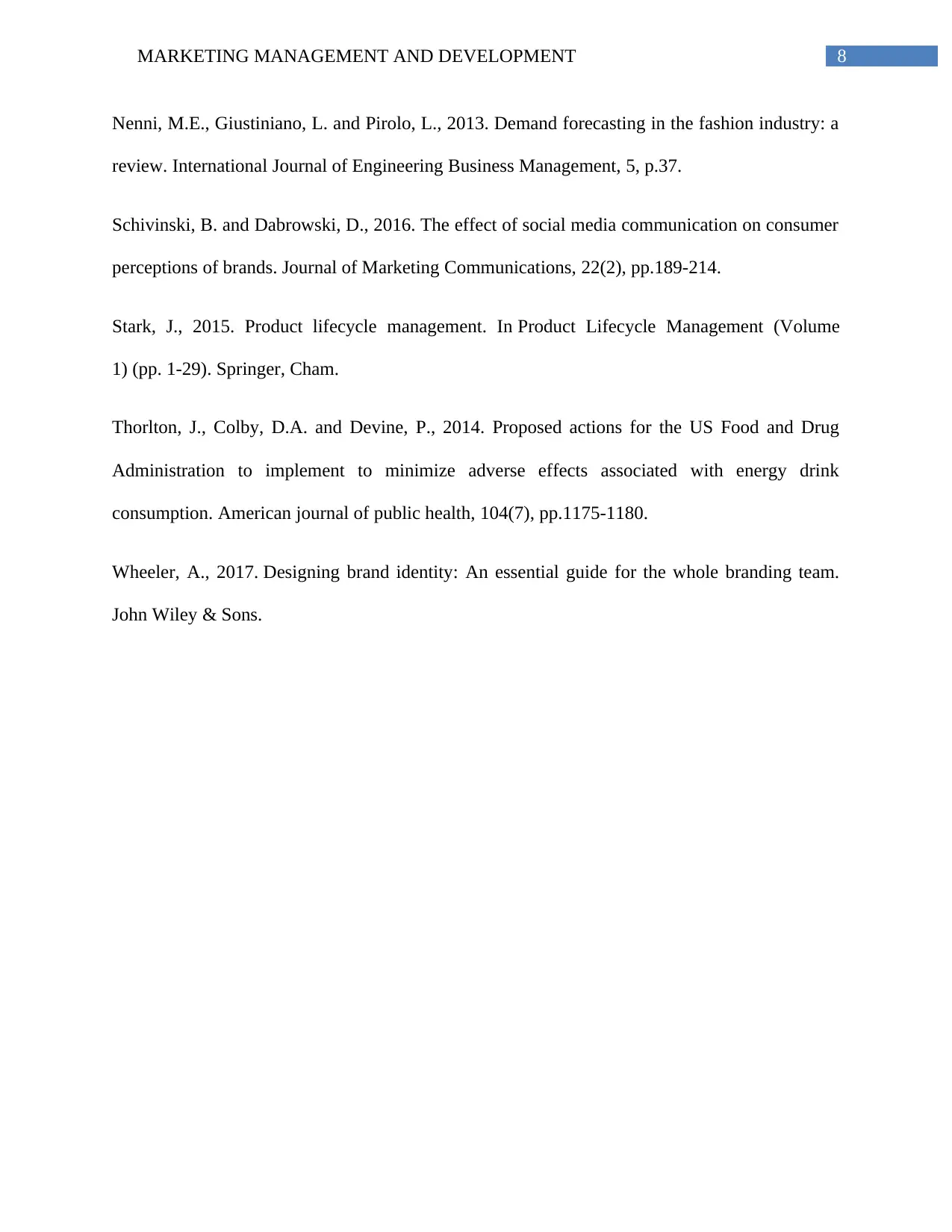
8MARKETING MANAGEMENT AND DEVELOPMENT
Nenni, M.E., Giustiniano, L. and Pirolo, L., 2013. Demand forecasting in the fashion industry: a
review. International Journal of Engineering Business Management, 5, p.37.
Schivinski, B. and Dabrowski, D., 2016. The effect of social media communication on consumer
perceptions of brands. Journal of Marketing Communications, 22(2), pp.189-214.
Stark, J., 2015. Product lifecycle management. In Product Lifecycle Management (Volume
1) (pp. 1-29). Springer, Cham.
Thorlton, J., Colby, D.A. and Devine, P., 2014. Proposed actions for the US Food and Drug
Administration to implement to minimize adverse effects associated with energy drink
consumption. American journal of public health, 104(7), pp.1175-1180.
Wheeler, A., 2017. Designing brand identity: An essential guide for the whole branding team.
John Wiley & Sons.
Nenni, M.E., Giustiniano, L. and Pirolo, L., 2013. Demand forecasting in the fashion industry: a
review. International Journal of Engineering Business Management, 5, p.37.
Schivinski, B. and Dabrowski, D., 2016. The effect of social media communication on consumer
perceptions of brands. Journal of Marketing Communications, 22(2), pp.189-214.
Stark, J., 2015. Product lifecycle management. In Product Lifecycle Management (Volume
1) (pp. 1-29). Springer, Cham.
Thorlton, J., Colby, D.A. and Devine, P., 2014. Proposed actions for the US Food and Drug
Administration to implement to minimize adverse effects associated with energy drink
consumption. American journal of public health, 104(7), pp.1175-1180.
Wheeler, A., 2017. Designing brand identity: An essential guide for the whole branding team.
John Wiley & Sons.
⊘ This is a preview!⊘
Do you want full access?
Subscribe today to unlock all pages.

Trusted by 1+ million students worldwide
1 out of 9
Related Documents
Your All-in-One AI-Powered Toolkit for Academic Success.
+13062052269
info@desklib.com
Available 24*7 on WhatsApp / Email
![[object Object]](/_next/static/media/star-bottom.7253800d.svg)
Unlock your academic potential
Copyright © 2020–2025 A2Z Services. All Rights Reserved. Developed and managed by ZUCOL.





